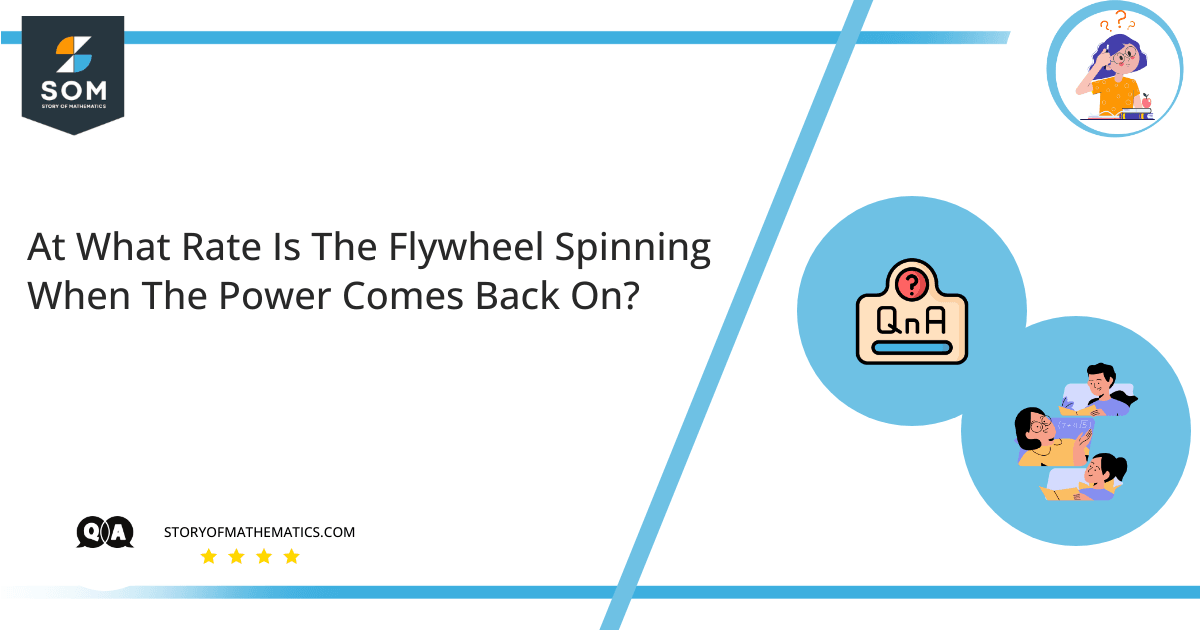
- At what rate is the flywheel spinning when the power comes back on?
- How long after the beginning of the power failure would it have taken the flywheel to stop if the power had not come back on, and how many revolutions would the wheel have made during this time?
The question aims to find the rate at which the flywheel spins when the power returns. It also asks to find revolutions the flywheel made when the power failed.
The rate of change of angular motion is called angular velocity and is expressed as follows:
$\omega=\dfrac{\theta}{t}$
Where $\theta$ is angular displacement, $t$ is the time, and $\omega$ is angular speed.
Angular velocity has two types. Orbital angular velocity determines how fast a point object turns to a fixed root, i.e., the degree of time change of its angular position relative to the origin. Spin angular velocity determines how fast a solid body rotates about its rotation position and is independent of the original choice, in contrast to the angular speed. Radians per second is the $SI$ unit of angular velocity. Angular velocity is normally represented by the omega symbol $(\omega, sometimes Ω)$.
Expert Answer
Part(a)
Given parameters:
-initial angular speed of the wheel, $\omega_{i}=500\: rpm$
–diameter of the flywheel $d=75\:cm$
-a mass of the flywheel, $=40\:kg$
–time, $t=30\:s$
–number of revolutions of the flywheel,$N=200$
The angular acceleration of the fly wheel is calculated as
\[\theta=\omega_{i}t+\dfrac{1}{2}\alpha t^{2}\]
\[(200 rev \times \dfrac{2\pi rad}{1 rev}=(500\dfrac{rev}{min}\times \dfrac{2\pi \:rad}{1 \:rev}\times \dfrac{1\:min}{60\:s})(30\:s)+\dfrac{1}{2}(30\:s)^{2}(\alpha)\]
\[1256.8=1571+450\alpha\]
\[450\alpha=-314.2\]
\[\alpha=\dfrac{-314.2}{450}\]
\[\alpha=-0.698 \dfrac{rad}{s^{2}}\]
The final angular speed of the fly wheel is calculated as:
\[\omega_{f}=\omega_{i}+\alpha t\]
\[\omega_{f}=(500\dfrac{rev}{1\:min}\times \dfrac{2\pi \: rad}{1\:rev}\times \dfrac{1\:min}{60\:s})+(-0.698\times 30)\]
\[\omega_{f}=52.37-20.94\]
\[\omega_{f}=31.43\dfrac{rad}{s}\]
\[\omega_{f}=300\:rpm\]
Part(b)
The time required for the flywheel to stop when the power did not return is calculated as follows:
\[\omega_{f}=\omega_{i}+\alpha t\]
\[0=52.37-(0.698t)\]
\[0.698t=52.37\]
\[t=\dfrac{52.37}{0.698}\]
\[t=75\:s\]
The number of revolutions the wheel would have made during this time is calculated as follows:
\[\theta=(\dfrac{\omega_{i}+\omega_{f}}{2}t)\]
\[\theta=(\dfrac{52.37+0}{2}75)\]
\[\theta=1963.75\:rad\]
\[\theta=\dfrac{1\:rev}{2\pi\:rad}\times 1963.75\:rad\]
\[\theta=312.5\:rev\]
Numerical Results
(a)
The rate at which the flywheel spins when the power comes back is calculated as:
\[\omega_{f}=300\:rpm\]
(b)
The total number of revolutions is:
\[\theta= 312.5\:rev\]
Example
The high-speed flywheel in the car rotates to $ 600 \: rpm $ in the event of a power failure. The flywheel has a weight of $ 50.0 \: kg $ and a width of $ 75.0 \: cm $. Power is closed for $40.0 \: s $, and during this time, the flywheel slows down due to a collision of its axle bearings. When the power is off, the flywheel makes $ 200 $ complete revolutions.
$(a)$ At what rate does the flywheel rotate when the power returns?
$(b)$ How long would it take after the power outage started for the flywheel to stop when power went out, and how many revolutions would the tire perform during this time?
Solution
Part(a)
Given parameters:
-initial angular speed of the wheel, $\omega_{i}=600\: rpm$
–diameter of the flywheel $d=75\:cm$
–mass of the flywheel, $=50\:kg$
–time, $t=40\:s$
–number of revolutions of the flywheel, $N=200$
The angular acceleration of the fly wheel is calculated as
\[\theta=\omega_{i}t+\dfrac{1}{2}\alpha t^{2}\]
\[(200 rev \times \dfrac{2\pi rad}{1 rev}=(500\dfrac{rev}{min}\times \dfrac{2\pi \:rad}{1 \:rev}\times \dfrac{1\:min}{60\:s})(25\:s)+\dfrac{1}{2}(25\:s)^{2}(\alpha)\]
\[1256.8=1309+312.5\alpha\]
\[312.5\alpha=-52.2\]
\[\alpha=\dfrac{-52.2}{312.5}\]
\[\alpha=-0.167\dfrac{rad}{s^{2}}\]
The final angular speed of the fly wheel is calculated as:
\[\omega_{f}=\omega_{i}+\alpha t\]
\[\omega_{f}=(500\dfrac{rev}{1\:min}\times \dfrac{2\pi \: rad}{1\:rev}\times \dfrac{1\:min}{60\:s})+(-0.167\times 25)\]
\[\omega_{f}=52.36-4.175\]
\[\omega_{f}=48.19\dfrac{rad}{s}\]
\[\omega_{f}=460\:rpm\]
Part(b)
The time required to stop the flywheel when the power did not return is calculated as follows:
\[\omega_{f}=\omega_{i}+\alpha t\]
\[0=52.36-(0.167t)\]
\[0.167t=52.37\]
\[t=\dfrac{52.37}{0.698}\]
\[t=313.6\:s\]
The number of revolutions the wheel would have made during this time is calculated as follows:
\[\theta=(\dfrac{\omega_{i}+\omega_{f}}{2}t)\]
\[\theta=(\dfrac{52.37+0}{2}75)\]
\[\theta=8195.9\:rad\]
\[\theta=\dfrac{1\:rev}{2\pi\:rad}\times 8195.9\:rad\]
\[\theta=1304.4\:rev\]
